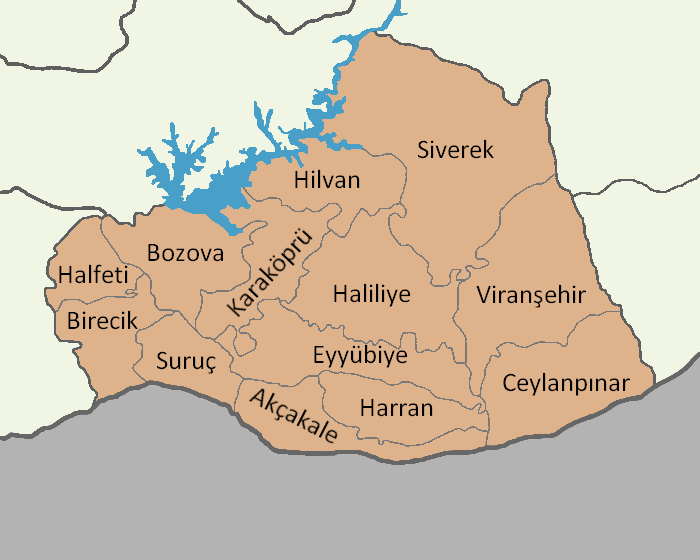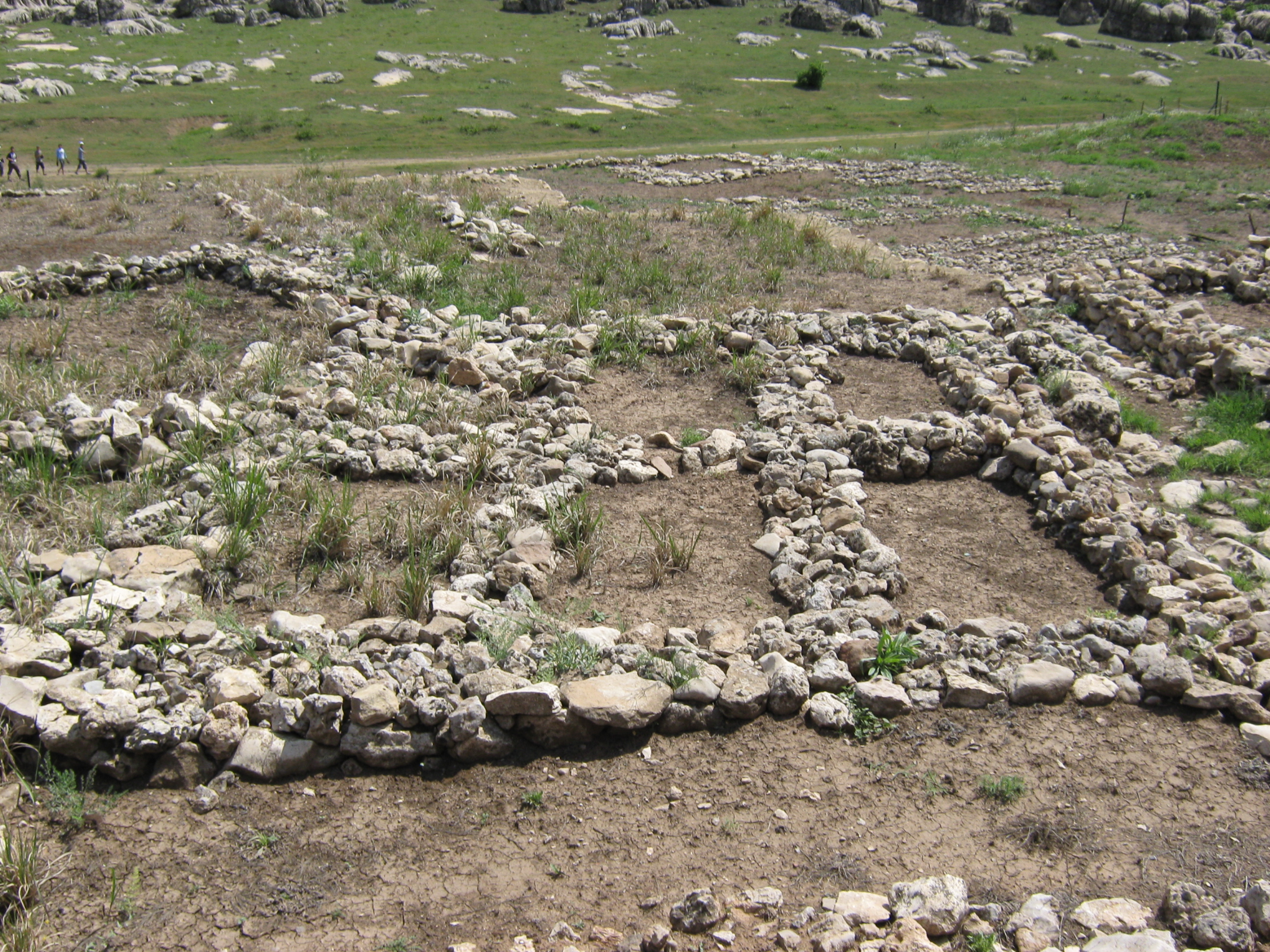|
Nevalı Çori
Nevalı Çori ( tr, Nevali Çori, ku, Newala Çorî) was an early Neolithic settlement on the middle Euphrates, in Şanlıurfa Province, Southeastern Anatolia, Turkey. The site is known for having some of the world's oldest known temples and monumental sculpture. Together with the earlier site of Göbekli Tepe, it has revolutionised scientific understanding of the Eurasian Neolithic period. The oldest domesticated Einkorn wheat was found there. The settlement was located about 490 m above sea level, in the foothills of the Taurus Mountains, on both banks of the Kantara stream, a tributary of the Euphrates. Excavation The site was examined from 1983 to 1991 in the context of rescue excavations during the erection of the Atatürk Dam below Samsat. Excavations were conducted by a team from the University of Heidelberg under the direction of Professor Harald Hauptmann. Together with numerous other archaeological sites in the vicinity, Nevalı Çori has since been inundated by the dam ... [...More Info...] [...Related Items...] OR: [Wikipedia] [Google] [Baidu] |
Şanlıurfa Province
Şanlıurfa Province ( tr, Şanlıurfa ili; ku, Parêzgeha Rihayê) or simply Urfa Province is a province in southeastern Turkey. The city of Şanlıurfa is the capital of the province which bears its name. The population is 1,845,667 (2014). The province is considered part of Turkish Kurdistan and has a Kurds, Kurdish majority with a significant Arabs, Arab and Turkish people, Turkish minority. Districts Şanlıurfa province is divided into 13 Districts of Turkey, districts (capital district in bold): * Urfa (Central district. In 2014 it was split into three districts: Eyyübiye, Haliliye and Karaköprü.) * Akçakale * Birecik * Bozova * Ceylanpınar * Halfeti * Harran * Hilvan * Siverek * Suruç * Viranşehir Geography Area 18,584 km2 (7,173 sq. miles), the largest province of Southeast Anatolia with: * Adıyaman to the north; * Syria to the south; * Mardin and Diyarbakır to the east; * Gaziantep to the west; Şanlıurfa includes several major components of the ... [...More Info...] [...Related Items...] OR: [Wikipedia] [Google] [Baidu] |
Dry Stone Wall
Dry stone, sometimes called drystack or, in Scotland, drystane, is a building method by which structures are constructed from stones without any mortar to bind them together. Dry stone structures are stable because of their construction method, which is characterized by the presence of a load-bearing façade of carefully selected interlocking stones. Dry stone construction is best known in the context of stone walls, traditionally used for the boundaries of fields and churchyards, or as retaining walls for terracing, but dry stone sculptures, buildings, bridges, and other structures also exist. The term tends not to be used for the many historic styles which used precisely-shaped stone, but did not use mortar, for example the Greek temple and Inca architecture. The art of dry stone walling was inscribed in 2018 on the UNESCO representative list of the intangible cultural heritage of humanity, for dry stone walls in countries such as France, Greece, Italy, Slovenia, Cro ... [...More Info...] [...Related Items...] OR: [Wikipedia] [Google] [Baidu] |
Monolith
A monolith is a geological feature consisting of a single massive rock (geology), stone or rock, such as some mountains. For instance, Savandurga, Savandurga mountain is a monolith mountain in India. Erosion usually exposes the geological formations, which are often made of very hard and solid igneous rock, igneous or metamorphic rock. Some monoliths are volcanic plugs, solidified lava filling the vent of an extinct volcano. In architecture, the term has considerable overlap with megalith, which is normally used for prehistory, and may be used in the contexts of rock-cut architecture that remains attached to solid rock, as in monolithic church, or for exceptionally large stones such as obelisks, statues, monolithic columns or large architraves, that may have been moved a considerable distance after quarrying. It may also be used of large glacial erratics moved by natural forces. The word derives, via the Latin , from the Ancient Greek word (), from () meaning "one" or "sing ... [...More Info...] [...Related Items...] OR: [Wikipedia] [Google] [Baidu] |
Terrazzo
Terrazzo is a composite material, poured in place or precast, which is used for floor and wall treatments. It consists of chips of marble, quartz, granite, glass, or other suitable material, poured with a cementitious binder (for chemical binding), polymeric (for physical binding), or a combination of both. Metal strips often divide sections, or changes in color or material in a pattern. Additional chips may be sprinkled atop the mix before it sets. After it is cured it is ground and polished smooth or otherwise finished to produce a uniformly textured surface. "Terrazzo" is also often used to describe any pattern similar to the original terrazzo floors. History Terrazzo proper Although the history of terrazzo can be traced back to the ancient mosaics of Egypt, its more recent predecessors come from Italy. The form of terrazzo used today derives partly from the 18th century ''pavimento alla Veneziana'' ( Venetian pavement) and the cheaper ''seminato.'' ''Pavimento alla Venezi ... [...More Info...] [...Related Items...] OR: [Wikipedia] [Google] [Baidu] |
Mezzanine
A mezzanine (; or in Italian language, Italian, a ''mezzanino'') is an intermediate floor in a building which is partly open to the double-height ceilinged floor below, or which does not extend over the whole floorspace of the building, a loft with non-sloped walls. However, the term is often used loosely for the floor above the ground floor, especially where a very high-ceilinged original ground floor has been split horizontally into two floors. Mezzanines may serve a wide variety of functions. Industrial mezzanines, such as those used in warehouses, may be temporary or semi-permanent structures. In Royal Italian architecture, ''mezzanino'' also means a chamber created by partitioning that does not go up all the way to the arch vaulting or ceiling; these were historically common in Italy and France, for example in the palaces for the nobility at the Quirinal Palace. Definition A mezzanine is an intermediate floor (or floors) in a building which is open to the floor below. It ... [...More Info...] [...Related Items...] OR: [Wikipedia] [Google] [Baidu] |
Mureybet
Mureybet ( ar, مريبط, muribit, lit=covered) is a tell, or ancient settlement mound, located on the west bank of the Euphrates in Raqqa Governorate, northern Syria. The site was excavated between 1964 and 1974 and has since disappeared under the rising waters of Lake Assad. Mureybet was occupied between 10,200 and 8,000 BC and is the eponymous type site for the Mureybetian culture, a subdivision of the Pre-Pottery Neolithic A (PPNA). In its early stages, Mureybet was a small village occupied by hunter-gatherers. Hunting was important and crops were first gathered and later cultivated, but they remained wild. During its final stages, domesticated animals were also present at the site. History of research The first archaeological investigation of the site was carried out in 1964. In that year, the site was noted during an archaeological survey of the region directed by Maurits N. van Loon of the Oriental Institute of the University of Chicago, and a small sounding was mad ... [...More Info...] [...Related Items...] OR: [Wikipedia] [Google] [Baidu] |
Radiocarbon Dating
Radiocarbon dating (also referred to as carbon dating or carbon-14 dating) is a method for determining the age of an object containing organic material by using the properties of radiocarbon, a radioactive isotope of carbon. The method was developed in the late 1940s at the University of Chicago by Willard Libby. It is based on the fact that radiocarbon () is constantly being created in the Earth's atmosphere by the interaction of cosmic rays with atmospheric nitrogen. The resulting combines with atmospheric oxygen to form radioactive carbon dioxide, which is incorporated into plants by photosynthesis; animals then acquire by eating the plants. When the animal or plant dies, it stops exchanging carbon with its environment, and thereafter the amount of it contains begins to decrease as the undergoes radioactive decay. Measuring the amount of in a sample from a dead plant or animal, such as a piece of wood or a fragment of bone, provides information that can be used to calc ... [...More Info...] [...Related Items...] OR: [Wikipedia] [Google] [Baidu] |
Çayönü
Çayönü Tepesi is a Neolithic settlement in southeastern Turkey which prospered from circa 8,630 to 6,800 BC. It is located forty kilometres north-west of Diyarbakır, at the foot of the Taurus mountains. It lies near the Boğazçay, a tributary of the upper Tigris River and the Bestakot, an intermittent stream. It is an early example of agriculture. Archaeology The site was excavated for 16 seasons between 1964 and 1991, initially by Robert John Braidwood and Halet Çambel and later by Mehmet Özdoğan and Aslı Erim Özdoğan. The settlement covers the periods of the Pre-Pottery Neolithic A (PPNA), the Pre-Pottery Neolithic B (PPNB), and the Pottery Neolithic (PN). The stratigraphy is divided into the following subphases according to the dominant architecture: *round, PPNA *grill, PPNA *channeled, Early PPNB *cobble paved, Middle PPNB *cell, Late PPNB *large room, final PPNB An analysis of blood found at the site suggested that human sacrifice occurred there. Origin ... [...More Info...] [...Related Items...] OR: [Wikipedia] [Google] [Baidu] |
.jpg)





